November 28, 1885
The first international soccer game played in America took place in East Newark on November 28, 1885. This was no quiet affair. More than 2,000 spectators made their way to a field across the Passaic River from Newark, just south of Kearny. The grassy expanse was home to the O.N.T. Athletic Association, a local powerhouse sponsored by the area’s major employer of Scottish immigrants, Clark Thread Mills. The Canadian national team was visiting, and a squad of American all-stars was raised from the industrial teams that played in the area, representing (albeit unofficially) the United States.
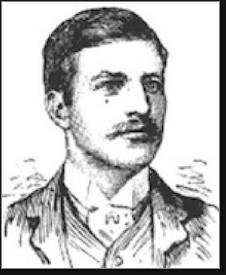
The American team hadn’t had a chance to practice together, but the players knew one another fairly well. Five were from the O.N.T. club, three came from the Kearny Rangers, two from Paterson’s Thistles and one from the Newark Almas. Both sides played a 2–2–6 formation, with six forwards. The game was rough. A reporter from The New York Times noted that the match devolved into fistfights and shoving matches a number of times. The final score was 1–0 in favor of the Canadians; the goal was scored by Alex Gibson (right).
This was the first international match played outside the British Isles. Canada, whose lineup was made up of players in the Ontario Football Association, stayed and played two more matches, defeating O.N.T. and the Almas before heading back north.
The Canadians returned to New Jersey on Thanksgiving Day in 1886 to play another picked team of Americans. This time, the Yanks were ready. They recovered from a 1–0 first-half deficit to triumph 3–2 in a driving rain. The three US goals were scored by Swarbick, Gray and McGurk.
March 27, 1927
To most soccer historians, the 1924 Olympics in Paris marked the first truly international soccer tournament. The Uruguayan national team startled European fans with crisp, creative passing on their way to the gold medal. The American squad—including Jersey Boy Jimmy Douglas—finished a distant 9th, managing one victory, against Estonia, before falling to Uruguay, 3–0.
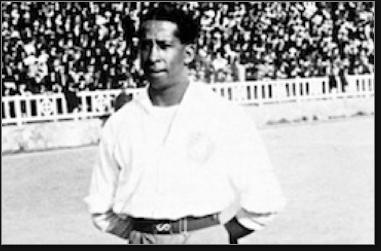
When Uruguay took the field at Newark’s Davids Stadium (later renamed Ruppert Stadium) in the spring of 1927, they hadn’t lost since their last meeting with the Americans. This time, the supremely confident visitors faced the Newark Skeeters, cheered on by 5,000 spectators. The Skeeters were nothing special—in fact, they were one of the least successful teams in the American Soccer League. The talk of the town that day actually was the 25-year-old Jose Andrade (above) aka “La Maravilla Negra,” who had established himself in Paris as the sport’s first black superstar in leading Uruguay to the gold medal. It was the third match of a 13-city tour for Nacional.
Ten minutes into the match, things began to unravel for Uruguay when two defenders sandwiched an American player in the penalty box and were whistled for a foul. After arguing unsuccessfully with referee James Walder, the outraged players threatened to leave the field if the Americans scored. Jock Marshall took the penalty kick and purposely booted it wide so the match could continue.
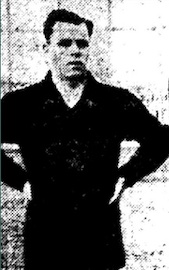
Alas, it was not Uruguay’s day.
Jack Renfrew scored a clean goal, sending the crowd into a frenzy. Minutes later, the Americans made a hard foul on Hector Castro, who had been using the stump of an arm he had lost to an electric saw at age 13 to bludgeon defenders.
With the Uruguayans desperate and angry, Pedro Cea was whistled for a foul and became so incensed that he punched the American player on the ground. The fans swarmed on the field and a free-for-all ensued. After order was restored, keeper Tommy Murdoch (right) stopped everything that came his way and the game ended 1–0.

April 2, 1977
The New York Cosmos, featuring international superstars like Pele and Giorgio Chinaglia, began their 8-year run in New Jersey with a preseason match against Victory of Haiti in the Tournament of Champions, held at their new home field, Giants Stadium in the Meadowlands. The Cosmos, jokingly known as America’s most famous sports team—“everywhere but America”—would finish in first place in the NASL’s Eastern Division six times and win four Soccer Bowls during that time.
In the years before their arrival in East Rutherford, the Cosmos called a number of venues home, and actually hosted a match in Jersey City’s Roosevelt Stadium in June 1971. The game against Dallas was moved from Yankee Stadium because of bad weather—the Yankees didn’t want their field torn up. As part of the deal to move to the Garden State in 1977, the Cosmos were forced to drop “New York” from their name by the New Jersey Sports & Exposition Authority. That lasted a year, and the old name was restored in 1978.
There were two inaugural Tournament of Champions matches played at the Meadowlands on April 2—both contested in a steady rain—and they drew more than 7,000 fans. In the opening game, the Tampa Bay Rowdies beat Toronto Metros-Croatia in a shootout following a scoreless regulation and overtime struggle. In the second game, the Cosmos totally overwhelmed their Haitian foes. Chinaglia netted the first goal and then added three more. Pele scored twice. Tony Field, Terry Garbett and Jomo Sono had one apiece. Shep Messing stopped 10 shot en route to a 9–0 clean sheet. The Victory players, unaccustomed to playing on wet artificial turf, were sliding all over the place, giving the Cosmos an advantage they hardly needed.
The following day, the Cosmos faced the Tampa Bay Rowdies for the Tournament of Champions title. All of the players were tired and they looked it. Chinaglia scored again and midfielder Vito Dimitrijevic added a goal to edge the Rowdies, 2–1. Each team had a goal waived off on an off-side call. In the consolation game, Victory lost again and were consistent about it. Toronto beat them 9–0. 11,098 fans watched the final round on a bright, sunny day.
October 1, 1977

When Pele concluded his 19-year career with the Brazilian club Santos in 1974, soccer fans believed he had nothing left to prove. They didn’t know Pele. He believed that America was the sport’s “sleeping giant” and, to jostle it into consciousness, he un-retired and joined the New York Cosmos of the North American Soccer League for the 1975 season. Public awareness of soccer skyrocketed during Pele’s three seasons with the Cosmos, who moved to Giants Stadium following the 1976 season. Youth soccer programs exploded in the decade after his arrival.
As Pele’s third season drew to a close—a season that saw the Cosmos win the ’76 NASL title—he decided his work here was done. He decided to retire during the October 1st “friendly” between the Cosmos and his old club, Santos, in the Meadowlands. Every seat in the stadium was sold, and the game was televised in America on Wide World of Sports, and to virtually every soccer-playing country in the world.
Pele suited up for Santos in the first half and scored the 1,281st and final goal of his career, rocking Giants Stadium. He played the second half in a Cosmos jersey, helping the team win, 2–1. Pele’s final lap around a soccer stadium was completed without his feet touching the ground. Cosmos goalies Erol Yasin and Shep Messing carried him all the way on their shoulders.
During the final minutes, a steady rain began to fall. Soccer fans liked to say the sky was crying that day. Pele himself was unable to hold back the tears during his own farewell speech.
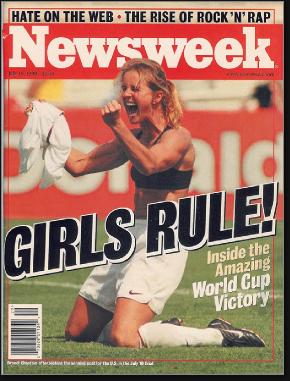
June 19, 1999
When FIFA announced that the 1999 Women’s World Cup would be held in the US, the Team USA players wondered how on earth they would fill the stadiums lined up for their games. Women’s soccer had only recently hit the American sports radar after Mia Hamm led the squad to a gold medal at the Atlanta Olympics in 1996. The opening game of the 1999 tournament was scheduled for Giants Stadium against Denmark. Interest for the match had been building for weeks, but the players were completely unprepared for what they encountered when they emerged from the dressing room.
Every seat in the 78,972-seat building was occupied by a screaming soccer fan. They could feel the ground shake and the cheers beat against their chests. Women’s soccer was officially on the map!
Their astonishment showed early in the match. They gave away several balls at midfield and allowed a Danish forward to sneak past the defense just a couple of minutes into the game. Fortunately, she missed wide-left. In the 17th minute, Brandi Chastain chipped a pass to Hamm, who popped the ball over the head of a defender to herself and then scored on a left-footed drive.
Team USA’s onslaught continued. The final 3–0 score hardly hints at the team’s superior end-to-end play. Julie Foudy and Kristine Lilly scored late to give the Americans a cushion.
The attendance figure of 78,972 established a world record for the most fans ever to attend a women’s sports event. At the time, it was also the largest crowd ever to watch a game of any kind at Giants Stadium. The US women went on to win the World Cup in Pasadena a few weeks later against China—a moment made indelible by Chastain’s iconic celebration after her game-winning penalty kick.
June 8, 2008
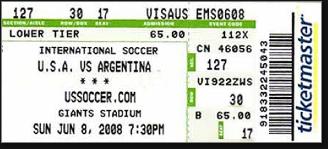
With World Cup 2010 on the horizon, the US men’s soccer team was gearing up to begin the qualifying process with a “friendly” match against Argentina, the #1 ranked team in the world. American soccer fans were expecting a drubbing, but hoped that goalkeeper Tim Howard—a Jersey Boy—might keep the score close. The draw of soccer’s top team and the growing popularity of soccer in America produced a crowd of 78,682. Fans cheered Landon Donovan prior to kickoff. He was playing in his 100th international match.
As expected, forwards Sergio Aguero and Julio Cruz led an attack that peppered the US goal with shots in the opening half. But Howard stopped all seven shots on goal, including two by Cruz on the same point-blank play. Howard denied Cruz again at close range after Cruz received a perfect pass from Lionel Messi. Howard stopped another Messi-Cruz combo near the end of the half.
Buoyed by his performance, the US defense tightened in the second half, shutting down the passing lanes and anticipating beautifully. The Argentines managed just a single shot in the final 45 minutes, and it sailed harmlessly over the back line. The final score of 0–0 was as good as a win for most American soccer fans. And Team USA almost pulled off a true upset.; a first-half shot by Clint Dempsey had missed by inches.

August 26, 2023
Red Bulls Stadium in Harrison was packed for the Major League Soccer debut of all-time great Lionel Messi of Inter Miami. Messi sat out the first half and entered the game to chants of We Want Messi from the record-shattering crowd. He entered as a substitute with Miami leading 1–0 in the 60th minute.
Messi drew loud cheers every time he touched the ball, but nothing compared to the response he triggered with an unbelievable play he made in the 89th minute. Jordi Alba, working on the right side of the Red Bulls’ box, left his feet to control an errant pass from Sergio Busquets and guide the ball to Messi, who was stationed in the middle of the field.
Messi collected the ball with his left foot and made two quick moves to lure defenders one way—they were expecting a left-footed shot—and then darted to his right before threading a perfect pass to the right side of the field with the outside of his left foot to 18-year-old Benjamín Cremaschi. The ball skittered inches away from four Red Bull defenders, turning them for a moment into spectators.
In that moment, Messi broke for the goal and received a pass back from Cremaschi, which he tapped into an unguarded net.
Was it the greatest goal in New Jersey history? Given the crowd, the historic moment and the sheer on-the-fly artistry, it is difficult to think of a better one.